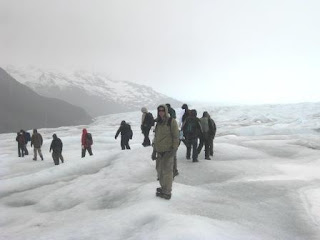

 The Perito Moreno (P.M.) Glacier is one of a dozen or so glaciers in the ‘Parque Nacional Los Glaciars’ (Glacier National Park) in the province of Santa Cruz, Patagonia – in southern Argentina. It’s the largest glacier in the park (at least by some measures) and the third largest on Earth behind those in Antarctica and Iceland. The stats on the P.M Glacier are: 30km in length, a surface area of 195km2, the width (or length) of the face is 4-5km, its face is 60-80 meters high. Other than its size, this glacier is unique as it is constantly advancing rather then receding like most other glaciers. Although its speedy 1-2 meters per day may seem sluggish, its enough to ensure that huge jagged pieces of ice frequently sheer from its face crashing into the lake, causing minor tsunamis and birthing new iceburgs.
The Perito Moreno (P.M.) Glacier is one of a dozen or so glaciers in the ‘Parque Nacional Los Glaciars’ (Glacier National Park) in the province of Santa Cruz, Patagonia – in southern Argentina. It’s the largest glacier in the park (at least by some measures) and the third largest on Earth behind those in Antarctica and Iceland. The stats on the P.M Glacier are: 30km in length, a surface area of 195km2, the width (or length) of the face is 4-5km, its face is 60-80 meters high. Other than its size, this glacier is unique as it is constantly advancing rather then receding like most other glaciers. Although its speedy 1-2 meters per day may seem sluggish, its enough to ensure that huge jagged pieces of ice frequently sheer from its face crashing into the lake, causing minor tsunamis and birthing new iceburgs. Our hostel pickup was at 7am. The first stop on our ‘Big Ice’ glacial trekking expedition, was at the observation deck (the balcony) at ‘Peninsula de Magallanes’ - opposite the centre of P. M. Glacier. From the balcony you could see amazing views of the glacier which is surprisingly blue in colour. It seemed every time we switched off our cameras a huge slab of ice would drop off the wall and crash dramatically into the lake. We were not too excited to notice grey clouds forming overhead and feel the spatter of occasional rain drops. This was not a good sign considering we were going to be walking on the ice for three hours and apart from a rain jacket, we were not wearing very water proof clothing (silly, I know but we were assured jeans were fine).





From the balcony we took a short bus ride to the shore of lake ‘Brazo Rico’ and then a boat across to the glacier. Once on the other side of the lake, we heard a loud crack (like a gun being fired) and turned to see a large full-length ice-block (120mx60m) disappear into the lake. Naturally, our cameras weren’t ready.
We were fitted with crampons (steel spikes that strap to shoes) and harnesses (in case we fall down a crevasse) and walked up through the forest along the edge of the glacier. About one kilometre inland (up-river) from the face of the glacier, we strapped on our crampons and started our four hour ice-trek across the glacier.
Leaving the shelter and relative warmth (even in rain) of the forest, we soon felt highly exposed, freezing cold and wet in the worsening wind and rain on the glacier. Through the steady stream of raindrops we saw: dark blue lagoons and deep crevasses - seemingly bottomless drains into which gushed glacial creeks (small rivers). We also viewed deep caves – all carved by rushing water, the slow grinding movement of ice and the shape of the valley below. What I hadn’t expected was the number of pebbles, rocks and enormous boulders suspended on or frozen into the middle of the ice. No doubt many years ago they had been picked up by the glacier and since then squeezed, turned and pummeled to the surface where they wait to be dropped into the watery depths of the lake.
We ate a lunch of dry buns with ham and cheese in the centre of the very wet and chilly glacier. Having tried and failed to enjoy lunch, we coldly made our way back to the boat via more glacial streams and lagoons - all amazing and natural ‘water-features’. We came across a glacial task that required Karyn to leap across a stream of not-quite-frozen-water, potentially beyond Karyn’s ligament’s level of flexibility in their frozen state. With the help of guides and me (as always) waiting with my water-logged camera (to record any fate that became her), Karyn jumped crossed the stream without incident. No longer hearing the grumbling of Karyn’s empty stomach the only sound to be heard on the galcier was the soft ‘pitter-patter’ of rain on the hood of my jacket, the ‘crunch-crunch’ of my crampons on the ice, and the soft gentle moaning of a drenched and slowly dying Karyn – painfully (and vocally) freezing to death on the idyllic Perito Moreno Glacier. I comforted my wife with the knowledge that as the frost-bite sets in, the pain would diminish – she wasn’t so easily consoled.
That everning we met with Fiona and celebrated our survival and the welcome feeling of warmth and dryness. We ate the famous patagonian lamb (lamb reared on glacial water and glacial grasses). Although Patagonian lamb was good (well worth the extortionate price we paid for it), it was not noticeably better than Australian lamb (lambs reared without grass or water).

No comments:
Post a Comment